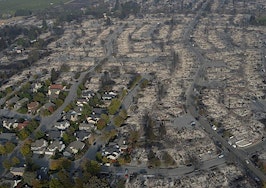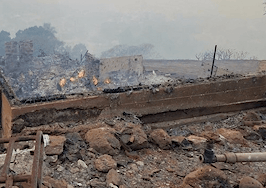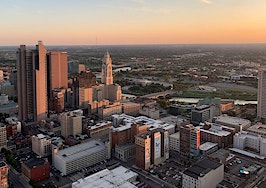Last week’s wildfire disaster in Northern California has drawn renewed attention to the impact of climate change on patterns of real estate development.
As a counterpoint to the attraction of waterfront property despite hurricane risks, the beauty of Northern California and other western regions has always been accompanied by a certain level of wildfire risk.
Until now, that risk seemed like a relatively small tradeoff for a quality of life that ranges from pleasant to absolutely stunning. However, with thousands of homes burned to the ground and the death count rising, the risk factor is also worth reevaluating.
The role of climate change
On a national basis, the numbers reveal a clear pattern: as the average global temperature rises, wildfires increase.
The Environmental Protection Agency lists wildfires among its climate change indicators and provides the statistics to back it up: Since 1983, the United States has had an average of 72,000 recorded wildfires per year. Of the 10 years with the largest acreage burned since 1983, nine have occurred since 2000 with many of the largest increases occurring in western states.
A similar pattern shows up in the total area affected. Nine of the 10 years with the highest number of acres burned have occurred since 2000.
A perfect storm of natural and human factors
The broad trend of rising temperatures has a ripple effect that intensifies other factors that have contributed to the Northern California fires.
EPA statistics indicate that increase in wildfires is more pronounced in the western U.S. in general, and particularly in parts of the West and Southwest where factors linked to climate change — drought, invasive weeds and earlier snowmelt — are at play.
Dr. Noah S. Diffenbaugh, a leading climate scientist at Stanford University’s Woods Institute for the Environment, provides this explanation:
Fire is a prime example of how climate interacts with other natural and human factors to create disaster risk, such as where we build, how we build, and how we manage forests.
There is clear evidence that global warming has already increased risk, via the role of temperature in increasing aridity. In terms of this particular situation, this is the kind of event that is consistent with historical trends and expectations: the most severe drought in California history, followed by record wet winter conditions, then a severely hot summer.
That extreme weather cycle resulted in an explosion of undergrowth that quickly dried and turned to tinder over the summer.
Mark Whitmore is a forest entomologist at Cornell University with a background in Northern California, who specializes in destructive pests. He emphasizes the human factors in the overload of dry shrubs and other tinder:
It’s not just climate change, it’s land management. Fires have been suppressed for so many years, and there’s a mixed forest in that area of oak, brush and pines. Shrubs can be highly flammable, and they burn fast.
Whitmore also draws a connection between climate change, the increase in tinder and an increase in forest destruction caused by invasive insects:
One of the biggest developments in the west is the mountain pine beetle. Its survival has been enhanced by climate change. They multiply and the area becomes a tinder box.
This increased risk has been well documented, and the US Forest Service has anticipated that mountain pine beetle infestations will result in “a fuels build-up situation that could result in catastrophic fires.”
The pine beetle is not the only pest at work in California. Last spring a report on the increased fire risk appeared in SFGate.com under the headline, “29 million trees dead from bark beetle infestation pose fire risk in California.”
Development and the web of wildfire risk
Rachel Cleetus, the lead economist for Energy and Climate Policy with the Union of Concerned Scientists advocacy organization, also emphasizes that climate change multiplies natural and human risk factors.
“Climate change is fueling hotter, drier conditions,” she explains. “The California fire season is not a season anymore, it is a year-long risk.”
Cleetus notes that development is an aspect of the human factor that comes into play for increased risk. For example, firefighting is more difficult and complicated in subdivisions where homes and other buildings inhibit access and contribute to the fuel load.
As bad as the Northern California wildfire disaster has been, more catastrophic incidents could be in store.
The global property information and analytics company CoreLogic has compared the pattern of development in Northern California with wildfire risks and concluded that “a total of 172,117 homes with a combined reconstruction cost value of more than $65 billion are at some level of risk from the wildfires in the Napa and Santa Rosa metropolitan areas.”
Just as communities in Texas are rethinking flood control in the aftermath of hurricanes Harvey and Irma, fire-prone areas will need to adjust policies and strategies to adapt to the impacts of climate change. Cleetus sums it up:
The impacts are here and now. This is not about some hypothetical future. Not doing anything is the most expensive option we can take.











